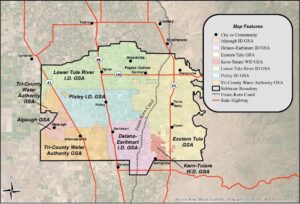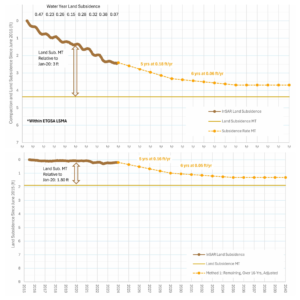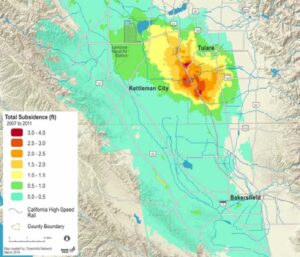When you’re done, you’re done.
And the Delano-Earlimart Irrigation District Groundwater Sustainability Agency (GSA) is done.
The district recently issued its new groundwater plan — purposely without coordination among the other groundwater agencies in the Tule subbasin.
In the San Joaquin Valley water world, that’s the equivalent of going rogue.
Especially as the Tule subbasin is about to go before the Water Resources Control Board for a probationary hearing Sept. 17.
Lack of coordination is an automatic no-go under the Sustainable Groundwater Management Act (SGMA), which requires agencies to agree on how groundwater will be measured, monitored and protected.

Without a coordination agreement, it’s highly likely the Tule subbasin will be put into probationary status, the first step toward a full state takeover of pumping. Even under probation, farmers will have to register their wells at $300 each, meter them, report extractions and pay $20 per acre foot pumped.
Probation is the SGMA “stick” water managers have worked to avoid since the act was passed in 2014.
Delano-Earlimart took this somewhat drastic action in hopes the state will carve it out from the rest of the Tule subbasin under the “good actor” clause. The clause was built into SGMA for groundwater agencies that are complying with the act, even if others aren’t.
Delano-Earlimart has mostly stable groundwater supplies, bumped up its surface supply purchases, increased its recharge facilities by nearly 500% and its farmers are not causing subsidence, or land sinking, according to the district’s groundwater plan.
“If DEID is unable to be exempted, then who could be?” General Manager Eric R. Quinley asked rhetorically.
Meanwhile, some of its neighboring groundwater agencies haven’t similarly invested in water supplies and haven’t put the brakes on over pumping resulting in rampant subsidence that continues to sink the Friant-Kern Canal and potentially damage Delano-Earlimart’s extensive pipeline system, Quinley said.

The other groundwater agencies did agree to a 1.5 mile buffer around Delano-Earlimart where certain actions would be required to reduce impacts of subsidence. Whether that would be protective enough hasn’t been studied and Quinley noted subsidence doesn’t stop at boundaries nor buffer zones.
“We’ve been airing our concerns with the other GSAs for the past eight years,” Quinley said. “The subbasin is in the process of producing its third round of groundwater plans and we still have not addressed some of the largest glaring issues. Meanwhile, the impacts continue to critical infrastructure, groundwater elevations and both domestic and agricultural wells on an almost unmitigated basis.
“It’s like groundhog day meets purgatory.”
The only other area in the Central Valley with worse subsidence is Delta-Mendota near Los Baños, Quinley said. But the Tule is sinking at such a rate, it will likely pass Delta-Mendota , making it the deepest area of subsidence in the nation.
Other district managers know the Tule subbasin has a subsidence problem and they are working on ways to reduce pumping, they said.
“My two GSAs have made a lot of efforts to become sustainable and we are making tough decisions,” said Eric Limas, general manager of the Lower Tule River and Pixley irrigation district GSAs. “I just got chewed out this morning over some things I’m recommending for our new plan.”
All of the groundwater agencies anticipate getting their plans out for public review by Aug. 8, signing a coordination agreement and presenting the whole package to the Water Board by the end of August.

Deanna Jackson, general manager of Tri-County Water Authority GSA, said reining in pumping isn’t just numbers on a page.
“It’s going to impact the livelihoods of a lot of people,” she said. “In fact, it’s already happening.”
She said GSA subsidence minimum thresholds only allow for another three feet of sinking.
“We can subside a foot a year in drought conditions, so three dry years and that puts a lot of people out of business,” Jackson said.
She and Limas both hoped Delano-Earlimart would sign the coordination agreement along with the rest of the Tule subbasin groundwater agencies.
Quinley said that was unlikely.
In fact, the executive summary of the district’s new groundwater plan states that it purposely deviates from the overall Tule subbasin coordination agreement because “…upholding the intent of SGMA to operate sustainably is more critical than agreeing to Subbasin-wide Plan elements that will likely prevent the Subbasin from achieving sustainability by 2040.”
“The rest of subbasin…they are…I think there is a recognition there are impacts but the resolution of what to do about those impacts has not come to any conclusion,” Quinley said.
Share this:
- Click to share on Facebook (Opens in new window)
- Click to share on Twitter (Opens in new window)
- Click to share on LinkedIn (Opens in new window)
- Click to share on Reddit (Opens in new window)
- Click to share on Tumblr (Opens in new window)
- Click to share on Pinterest (Opens in new window)
- Click to share on Pocket (Opens in new window)
- Click to share on Telegram (Opens in new window)
- Click to share on WhatsApp (Opens in new window)
- Click to print (Opens in new window)








You must be logged in to post a comment.